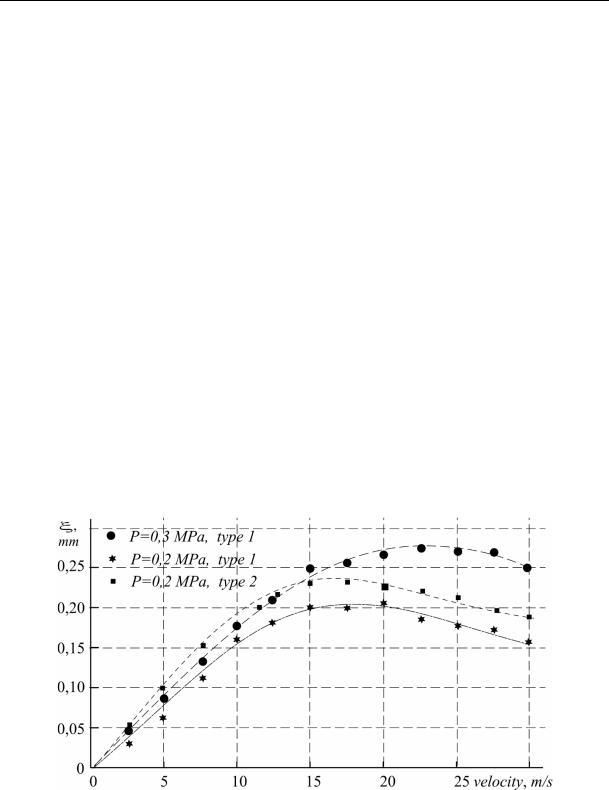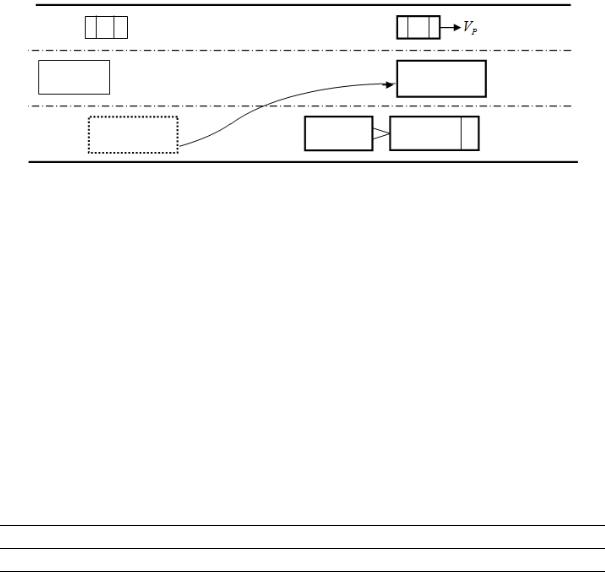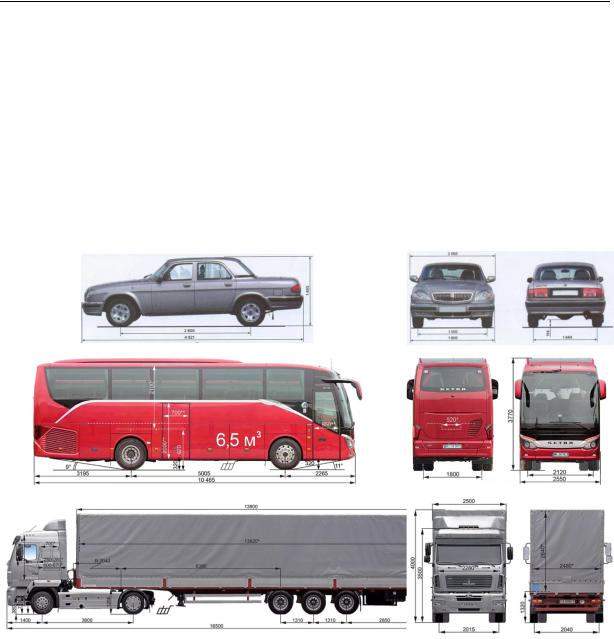
Учебное пособие 2174
.pdf
Russian Journal of Building Construction and Architecture
the maximum wear and tear on the pressure. Obviously, the quadratic dependence on the speed of movement is related to the kinetic energy of the vehicle and thus its release in the form of failure, while a logarithmic dependence is associated with its dissipation in the contact zone. As a result of the analysis, regression dependences of the wear and tear on the characteristics of the transport flow in the form were obtained
K1 2 K2 ln Ptire K3 0.01,
where is the speed of the vehicle, m/seс; Ptire is the pressure in the tires, МPа.
The coefficients of the resulting regression dependence are shown in Table. The change in the coefficients of the regression equation is caused by a study on two types of surfacings. At the same time, the more porous showed a higher amount of wear and tear, by 5––6 %, and lower speeds leading to failure of the surfacing.
|
|
|
Table |
Coefficients of theregression equation |
|
|
|
|
|
|
|
Surfacing |
K1×103 |
K2×103 |
K3×103 |
|
|
|
|
Asphalt concrete ЩМА-20 (porosity3%) |
–1.1 |
16.1 |
61.6 |
|
|
|
|
Asphalt concrete Б-2 (porosity5%) |
–1.2 |
15.4 |
54.2 |
|
|
|
|
Fig. 6. Wear and tear of different asphalt surfaces
Fig. 6 shows the experimental values of wear and tear for different asphalt surfacings, depending on the speed of vehicles with different tire pressures. The maximum wear and tear
90
Issue № 3 (51), 2021 |
ISSN 2542-0526 |
has moved to the range of lower velocity values, and there is a drop at higher wear and tear values, indicating a higher porosity of the surfacing.
The above connection between the speed of the vehicle and the intensity of wear and tear is expressed in the operation of friction on the dry and wet surfaces. As the intensity of wear and tear is identified based on the operational condition of the road surfacing, the impact on the surface depends not only on the internal pressure in the tire, but also on the course of action taken to reduce its water absorption.
Conclusions. A new system for recording the pressure in the pores of the upper layer of asphalt pavement has been developed allowing the maximum pressure in the contact zone of the sensor to the depth of its installation to be identified. For the first time, experimental data have been obtained based on the values of water pressure in the pores of the asphalt concrete surface when it is moistened under the action of the wheels of a moving traffic flow. Therefore it became possible to identify the maximum values of the pressure effect and the depth of penetration of the liquid pressure front. The analysis of the resulting data showed not only the presence of brittle fracture, but also the impact of moisture moving in the pores of asphalt concrete that exceeds its structural strength. Once the temperature reaches 15 °C, brittle fracture becomes comparable to plastic deformations. Using the experimental data, the regression dependences of the wear and tear value on the standard flow parameters were obtained. For operating surfaces the regression dependence allows the size of wear and tear to be predicted for the entire life cycle of the road.
Referencesc
1.Aleksandrov A. S., Aleksandrova N. P., Kuzin N. V. Metody teorii nasledstvennosti v raschetakh plasticheskikh de-formatsii materialov i gruntov pri vozdeistvii povtoryayushchikhsya nagruzok [Methods of the theory of heredity in the calculations of plastic deformations of materials and soils under the influence of repeated loads]. Transportnoe stroitel'stvo, 2009.
2.Bakhrakh G. S. Raschet usileniya dorozhnykh odezhd nezhestkogo tipa po kriteriyu ustalostnogo rastreskivaniya [Calculation of strengthening of non-rigid road coverings according to the criterion of fatigue cracking]. Nauka i tekhnika v dorozhnoi otrasli, 1999, no. 2, pp. 21––25.
3.Volkov V. V., Suslin M. A. Mikrovolnovyi rezonansnyi metod dlya issledo-vaniya svch poter' v kaplyakh vody na tverdoi poverkhnosti [A microwave resonant method for investigating microwave losses in water droplets on a solid surface]. Kondensirovannye sredy i mezhfaznye granitsy, 2015, no. 3, vol. 17, pp. 297––306.
4.Knyazev A. V., Volkov V. V., Kotov A. I. [The influence of the dynamic impact of transport vehicles on the road surface]. Sbornik nauchnykh trudov po materialam Mezhdunarodnoi nauchno-prakticheskoi
91

Russian Journal of Building Construction and Architecture
konferentsii “Perspektivy razvitiya nauki i obrazovaniya” [Proc. “Prospects for the development of science and education”], 2014, pp. 69––70.
5.Mel'kumov V. N., Matvienko F. V., Kanishchev A. N., Volkov V. V. Prognozirovanie velichiny neobratimoi deformatsii dorozhnoi konstruktsii ot vozdeistviya transportnogo potoka [Forecasting the magnitude of irreversible deformation of a road structure from the impact of a traffic flow]. Nauchnyi vestnik Voronezhskogo gosudarstvennogo arkhitekturno-stroitel'nogo universiteta. Stroitel'stvo i arkhitektura, 2010, no. 3, pp. 81––92.
6.Rudenskii A. V., Kalgin Yu. I. Dorozhnye asfal'tobetonnye pokrytiya na modifi-tsirovannykh bitumakh
[Road asphalt concrete coatings on modified bitumen]. Voronezh, Izd-vo VGASU, 2009. 142 p.
7.Arabani M., Mirabdolazimi S. M., Sasani A. R. The effect of waste tire thread mesh on the dynamic behaviour of asphalt mixtures. J. Constr. Build. Mater, 2010, vol. 24, pp. 1060––1068.
8.Fontes L. P. T. L., Triches G., Pais J. C, Pereira P. A. A. Evaluating permanent deformation in asphalt rubber mixtures. J. Constr. Build. Mater, 2010, vol. 24, pp. 1193––1200.
9.Kozlov V. A., Kotov A. I., Loboda A. V. Modelling Failures of Asphalt Concrete Surfacings Caused by a Dynamic Impact of Water. Russian Journal of Building Construction and Architecture, 2019, no. 2 (42), pp. 34––42.
10.Leng J. Characteristics and Behavior of Geogrid-Reinforced Aggregate under Cyclic Load: A Dissertation ... for the Degree of Doctor of Philosophy, 2002. 152 p.
11.Mahrez A., Karim M. R., Katman H. Y. Fatigue and deformation properties of glass fiber reinforced bituminous mixes. J. Eastern Asia, Soc. Trans. Stud., 2005, vol. 6, pp. 997––1007.
12.Mantzos L., Carpos P. European energy and transport: trends to 2030: update 2005. Belgium: European Commission.
13.Moghaddam T. B., Karim M. R., Abdelaziz M. A review on fatique andrutting performance of asphalt mixes. Scientific Research and Essays, 2011, vol. 6, pp. 670––682.
14.Navarro F. J., Partal P., Martínez-Boza F., Gallegos C. Thermorheological behaviour and storage stability of ground tirerubbermodified bitumens. Fuel, 2001, vol. 83, pp. 2041––2049.
15.Suo Z., Wong W. G. Analysis of fatigue crack growth behavior in asphalt concrete material in wearing course. J. Constr. Build. Mater, 2009, vol. 23, pp. 462––468.
16.Volkov V. V., Knyazev A. V., Melkumov V. N. Estimation of the dynamic effect of vehicles on an asphalt road surface. Russian Journal of Building Construction and Architecture, 2015, no. 1 (25), pp. 34––43.
17.Werkmeister S. Permanent deformation behaviour of unbound granular materials in pavement constructions. Ph. D. thesis, Universityof Technology, Dresden, Germany. 2003. 189 p.
18.Xu Q., Chen H., Prozzi J. A. Performance of fiber reinforced asphalt concrete under environmental temperature and water effects. J. Constr Build Mater, 2010, vol. 24, no. 10, pp. 2003––2010.
92

Issue № 3 (51), 2021 |
ISSN 2542-0526 |
DOI 10.36622/VSTU.2021.51.3.008
UDC625.7/.8
N. V. Shchegoleva1, V. V. Stolyarov2, A. V. Kochetkov3
THE PROCEDURE OF ANALYSIS, ASSESSMENT AND RISK REDUCTION
OF VEHICLE COLLISIONS ON A MULTI-LANE ROAD
Saratov State Technical University Named after Y. A. Gagarin1, 2
Russia, Saratov
Perm National Research Polytechnic University3
Russia, Perm
1PhD in Engineering, Assoc. Prof., Dept. of Transport Construction, tel.: 8-937-256-86-30, e-mail: Shegoleva123@mail.ru
2D. Sc. in Engineering, Prof., Dept. of Transport Construction, tel.: 8-917-217-75-10, e-mail: stolyarov_v_v@mail.ru
3D. Sc. in Engineering, Prof., Dept. of Cars and Technological Machines, tel.: 8-906-306-95-53, e-mail: soni.81@mail.ru
Statement of the problem. The problem of ensuring the safety of vehicles on a multi-lane roadway of the required width of coverage is considered based on the risk-oriented approach, in accordance with the Federal law of the Russian Federation No. 184 –– FZ "on technical regulation".
Results. The authors presented the applicability of the algorithm to assess the risk of interaction of vehicles on six-lane highways for determining regulatory performance; identify the required values of coating thickness for the design; decision-making on the improvement of the transverse profile when major repairs and reconstruction, as well as to develop recommendations for ODD.
Conclusions. It was found that in normative documents for design of six-lane roads, the design vehicle should provide the change of normalized coating thickness, increasing it to values at which the risk of collision of vehicles does not exceed the permissible value.
Keywords: risk theory, technical regulation, six-lane highway, roadway width, permissible risk, provided speed, traffic safety.
Introduction. What makes the study at hand particularly relevant is the compulsory application of a risk-oriented approach for all areas of road management, including recommendations for development, design, construction and operation (maintenance, repair and reconstruction) of roads. In an earlier published [9], the influence of the parameters of the width of the surfacing on the safety of vehicles was shown and a method for identifying the permissible speed on narrow sections of the highway based on the amount of allowable risk was developed.
© Shchegoleva N. V., Stolyarov V. V., Kochetkov A. V., 2021
93

Russian Journal of Building Construction and Architecture
On top of the issues discussed in this article, it is necessary to establish the required and acceptable parameters of the width of the surfacing of multi-lane roads on the basis of risk assessments. Previously, in view of the risk analysis, the joint solution of a number of problems was not considered, including: normalization of the width of lanes and edge lanes; design of a cross section of a multilane road and quality of construction of road elements. The aim of the study is to assign the width of the surfacing of multi-lane roads in compliance with the riskoriented approach, in accordance with the Federal Law of the Russian Federation № 184 –– Federal Law "On Technical Regulation".
1. Algorithm for calculating the risk of overtaking lane changes on a six-lane highway.
From the viewpoint of traffic safety, the major element of the cross profile of the road is the width of the roadway and the edge of the fortified lanes. The value of these elements is accepted depending on the category of the road and should remain constant on straight sections of the route and on curves in terms of large radius since on the curves of small radius surfacing becomes wider [1––4].
The surfacing width and that of the sidewalks of the highway directly impacts the likelihood of an accident. E.g., in the case of a local narrowing of the surfacing on a multi-lane road, the likelihood of a collision of vehicles while overtaking with a change of lane goes up considerably compared to the overtaking with no maneuver.
The lane width is set depending on the speed and dimensions of vehicles. Insufficient lane width does not provide safe traffic with design speeds and a permissible level of risk, excessive width increases the cost of one of the most costly elements of the road, i.e., surfacing when the risk level is less than acceptable.
Lane change schemes for overtaking a slow-moving car can vary considerably, both in the direction of the maneuver (left, right) and in the composition of the vehicles involved in the reconstruction. Note that in the suggested mathematical models of risk theory, any schemes of interaction of cars are applicable, but as the major scheme of movement of vehicles should rely on the most dangerous scheme of reconstruction of cars. One of the most dangerous scenario is when traffic schemes on the six-lane highway will the scheme of changing the lane by a large class bus from the right extreme lane to the middle one (Fig. 1). At the same time, the change of lane with a maneuver to the left corresponds to the bus ahead of the train (see Fig. 1), when a car with the calculated speed for this category of road moves along the extreme left lane in the same line. Maneuvering a bus on a six-lane highway is acceptable as the bus is carrying people, has large dimensions and can develop high speeds making accidents involving the bus classed as severe. The most dangerous scenario is when the bus is near the
94

Issue № 3 (51), 2021 |
ISSN 2542-0526 |
road train (in the middle lane) as a result of a lane change and all vehicles, including a car, are in one line along the width of the roadway (Fig. 1) [11, 12, 14––20].
Fig. 1. Scheme for identifying the risk of overtaking on a six-lane highway: р − is the design speed of a vehicle
The above scheme corresponds to the actual and most dangerous reconstruction on the sixlane highway. Note that the most dangerous scenario is when the train feels the reconstruction, but such a scheme is less realistic and can be seen as an exception. Note that while using this mathematical model created by designers, it is necessary to apply the composition of the movement of vehicles, which is justified in the design of the highway. Types of vehicles (Fig. 2), located in one line and their main dimensions are taken according to Table 1 [13].
Table 1
Dimensional characteristics of vehicles
|
|
Vehicle |
Intercitybus |
|
Road train |
|
|
GAZ 3110 «Volga») |
Setra S411 |
|
|
||
Rut, m |
с |
= 1.80 |
с |
= 2.55 |
с |
= 2.04 |
Width, m |
|
= 1.5 |
|
= 1.80 |
|
= 2.15 |
Length, m |
|
|
|
|||
|
= 4.921 |
|
= 10.465 |
|
= 16.50 |
|
|
|
|
|
|||
Therefore in this article the risk [5––10] of interaction of vehicles on the six-lane highway with the central dividing strip where the likelihood of a road accident during overtaking with a change of a lane is predicted is given by the formula:
. . = 0,5 − |
|
|
|
ВПР |
|
ВКР |
|
, |
|
|
|
|
|
|
|
|
|||
Ф |
ВПР |
− |
+ |
ВКР |
(1) |
||||
ДУ |
|
доп |
|
|
|||||
|
|
|
|
|
|
||||
where ВПР − is the design surfacing width (a reinforced surface) in one direction of movement, including the width of a three-lane carriageway and that of the reinforced lanes on the
95

Russian Journal of Building Construction and Architecture
right sidewalk and the central dividing lane. (At separate designing of counter directions of movement the parameter ВПР includes the width of the reinforced lanes on both roadways), m;
ВКР − is the critical width of the coating corresponding to the 50 % risk of an accident (where the bus maneuvers, and the car and train travel in the extreme left and right lanes, respectively).
At the same time the bus maneuvers from the extreme right lane to the middle one overtaking
the road train; |
Вдоп |
|
is the permissible descending standard deviation of the width of the sur- |
||
|
|
ПР |
|
|
|
facing, m; |
ВКР |
− |
is the standard deviation ofthe critical width ofthe surfacing, m. |
||
|
|
− |
|
||
Fig. 2. Dimensional characteristics of vehicles taken into consideration
This approach enables one to address the following problems:
to identify the risk of the width parameters of the six-lane road normalized in the current GOST (ГОСТ) and SP (CП);
to designthe surfacing widthwiththe permissible value ofthe risk ofcollisionofvehicles ahead ofthe change oflanes(for anyparametersofvehiclesonthe multi-lane roadway);
to improve the cross-sections of existing multi-lane roads based on assessing and reducing the risk of accidents to a permissible value in the process of maneuvering ahead of high-speed vehicles of low-speed vehicles on the multi-lane roadway;
96

Issue № 3 (51), 2021 |
ISSN 2542-0526 |
to develop guidelines for changing the organization of traffic on existing roads (with a justification of the permissible speeds indicated on signs 3.24, at which the risk of collision of vehicles will be permissible).
2.Method of normalization of parameters of width of the surfacing of a six-lane road.
Input parameters. Vehicle speeds:
a car (GAZ 3110 "Volga"), as already noted, is moving at a design speed for this cat-
|
the Setra S411 intercity bus= |
|
= 120 ⁄ = 33,33 |
⁄ |
); |
⁄ |
|
|
|
egory of six-lane road ( |
р |
|
80 |
|
|
||
|
road train, moving at the speed |
|
;⁄ = 22,22 |
; |
||||
|
|
maneuvers at the speed |
⁄ |
|
|
|
||
lane width 3.75 m. |
|
70 ⁄ = 19,44 |
|
|
|
|
||
While driving on the inner lane of the car with the calculated speed, the risk of overtaking a large vehicle Setra S411 intercity bus on the normalized width of the surfacing according to the following procedure.
1. The critical width of the surfacing where 50 % of road accidents occur is given by the dependence
|
|
ВКР |
= |
|
× |
+ |
+ |
+ |
( |
+3,6)× |
|
+ + |
× |
+ |
|
+ |
, |
|
|
(2) |
|||||||
|
|
|
|
|
200 |
2 |
|
200 |
|
|
200 |
|
2 |
|
|
|
|||||||||||
where |
|
–– is the speed of the car (GAZ 3110 "Volga" equalling the calculated speed for the |
|||||||||||||||||||||||||
projected road, m/s; |
–– is the speed of the lane-shifting maneuver intercity bus Setra S411, |
||||||||||||||||||||||||||
m/sec; |
|
|
–– is the movement of the road train being overtaken , m/sec; |
|
|
|
are the |
||||||||||||||||||||
lengths of the corresponding vehicles, m; |
|
|
|
–– is the width of the vehicles,. . m;− |
. |
–– |
|||||||||||||||||||||
are ruts of the vehicles in the edge lanes, m. . . |
(10.465+3.6) ×22.22 |
|
|
|
|
||||||||||||||||||||||
|
|
|
|
ВКР |
4.921×33.33 |
1.8+1.5 |
|
|
|
|
|
|
|||||||||||||||
|
|
|
|
|
|
= |
|
200 |
+ |
2 |
|
+ |
|
200 |
|
|
+2.55+ |
|
|
|
|||||||
|
|
|
|
|
|
|
|
|
16.5×19.44 |
2.04+2.15 |
|
|
|
|
|
|
|
|
|||||||||
|
|
|
|
|
|
|
|
|
+ |
|
|
width+ |
of the surfacing= 10.28is given( ) by the expression |
|
|||||||||||||
|
|
|
|
|
|
|
|
|
|
critical |
|
||||||||||||||||
2. The standard deviation of the200 |
|
|
|
|
2 |
|
|
|
|
|
|
|
|
|
|
||||||||||||
КР |
|
|
( × |
) |
+( |
+3.6) |
× |
|
|
+ ( |
|
× |
) |
|
|
|
|
|
|
|
|
|
|||||
= |
|
|
|
|
|
600 |
|
|
|
|
|
|
= |
|
|
|
|
|
|
|
|
||||||
|
|
|
|
|
|
|
|
|
|
|
|
|
|
|
|
|
|
|
|
|
(3) |
||||||
|
|
|
|
|
(4.921×33.33) + (10.465+3.6) ×27.7 +(16.5×19.44) |
|
|
||||||||||||||||||||
|
|
|
|
= |
|
|
|
|
|
|
|
|
|
|
600 . |
|
|
|
|
|
|
= |
|
||||
|
|
|
|
|
|
|
|
|
|
|
|
|
|
|
= 0.79 ( |
) |
|
|
|
|
|
|
|
|
|
||
97

Russian Journal of Building Construction and Architecture
3. Permissible standard deviation ( ВдопПР) of the width of the surfacing in one direction of movement is given by the formula [5]:
|
|
|
доп |
|
= |
доп |
= 2.45×∆ |
доп |
× |
ПР |
, |
(4) |
||
where доп –– is the the |
ПР |
|
Н |
|
||||||||||
|
|
|
|
|
|
|
||||||||
|
|
|
permissible deviation of the surfacing width relative to the design |
|||||||||||
SNiP (СНиП) |
|
(∆ = 0.06ПР |
|
Н |
|
|
|
|
|
|
|
|
||
surfacing width |
доп |
), m; (see SP (СП) 78.13330.2012 Highways. Enabled edition of |
||||||||||||
∆ |
|
|
|
|
|
|
|
|
|
|
|
|
|
|
|
3.06.03-85);В |
|
|
В is the normalized width of the surfacing in one direction |
||||||||||
of the road, (m). The value of |
the parameter В |
|
(m) is identified dependeing on the structure |
|||||||||||
|
= |
|
|
Н |
|
|
|
|
|
|
||||
of a transverse profile. In a six-lane road, the cross-section consists of three lanes in one direction of 3.75 m, the edge lane of 0.75 m and the edge lane of the dividing lane of 1 m.
− |
is the normalized |
|
ВН |
= 3×3.75+0.75+1 = 13.00( |
) |
|
|
|
|||
|
|
|
|
|
|
; |
|
|
|
||
|
|
|
|
|
|
|
|
Н |
|
|
|
|
|
|
(permissible) distance between the diameters (m), through which the |
||||||||
measured deviation while assigning the road into operation ( |
|
|
) should not exceed |
||||||||
the diameters than the |
|
(∆ = 0.06) |
width. At smaller distances between |
||||||||
the permissible deviation |
доп |
|
, of the surfacing |
∆ = |
− |
|
|
|
|||
|
|
|
normalized one , the actual deviations of the surfacing width from the |
||||||||
design width must be less than 6 cm (0.06 m). The value of the parameter |
(m) is identified |
||||||||||
depending on the calculated speed of movement depending on (4). |
|
|
|
|
|||||||
where р is the |
= 0.147× |
р |
×3.6 = 0.147×120×3.6 = 17.64 |
(m), |
(5) |
||||||
|
|
|
|
|
|
|
|
||||
− design speed in this road category, km/h.
допПР = допН
= 2.45×0.06× |
13.00 |
= 0.08( ). |
17.64 |
4. The risk of an accident on a six-lane highway when a low-speed vehicle is being overtaken by a high-speed vehicle (intercity bus Setra S411) is given by formula (1).
ДУ |
= 0.5 − |
Ф |
|
|
доп − |
ВКР |
|
= 0.5− |
Ф |
|
13.00−10.28 |
= 0.00033. |
|
. . |
|
|
|
ВПР |
|
|
|
|
|
||||
|
|
|
|
|
|
|
0.08 +0.79 |
||||||
|
|
ВПР |
+ |
ВКР |
|
|
|||||||
|
|
|
|
|
|
|
|
|
|
||||
Conclusions:
1.According to the resulting risk, 3 cars from 10 000 on the six-lane highway in one direction of movement will be involved in a road accident due to the insufficient width of the surfacing.
2.Regulatory documents for the design of six-lane roads in the design composition of vehicles should allow for a change in the standard width of the surfacing, increasing it to a
value where the risk of collision of cars does not exceed the permissible one 1×10 .
98

Issue № 3 (51), 2021 |
ISSN 2542-0526 |
This solution is in compliance with the requirements of the law №184 "On Technical Regulation" (risk management by reducing to a permissible value) and government decree №806 from 17.08.2016 on the application of the risk-based approach [3].
3. Design of the surfacing width with a permissible value of risk of collision of vehicles
(at any parameters of vehicles on a multi-lane carriageway).
The algorithm for addressing this problem is the same as the one proposed for the first problem and is applied when the standard surfacing width does not allow for maneuvering of ve-
hicles with an acceptable value of risk ( |
|
). |
|
While designing the surfacing width, |
the iterative process of changing it should be employed |
||
|
1×10 |
|
|
until the risk of a car collision is reduced to a permissible value. Iterations begin with an increase in the design surfacing width in one direction of the road causing a decrease in the identified risk according to formula (1). The surfacing width where the risk of collision of
cars in front will be less than or equal to the allowable risk ( |
) is accepted as the re- |
|||
quired width provided that traffic on six-lane roads is safe. |
1×10 |
|
||
We accept the increased surfacing width according to the following scheme: |
||||
ВПР |
− |
ПР |
|
|
|
is design surfacing width in one direction of the six-lane road, (m). The value of the |
|||
parameter В (m) is determined depending on the design of the cross section. On the six-lane road, the transverse profile consists of three lanes in one direction of 3.75 m, the changed width of the safety lane on the roadside –– 1.00 m, with the same value of the edge lane on the central dividing lane –– 1.00 m.
ВПР = 3×3.75+1.00+1.00 = 13.25( ) ;
The permissible descending standard deviation ( Вдоп) of the surfacing width in one direction |
|||||||
|
|
|
|
|
ПР |
|
|
of movement is given by formula (4). |
13.25 |
= 0.083( ). |
|||||
ПР |
|
доп |
|
ПР |
|||
доп |
= 2.45×∆ |
|
× |
= 2.45×0.06× |
17.64 |
||
|
|
|
|||||
Then, the risk of an accident on a six-lane highway, when a low-speed vehicle is being overtaken by a high-speed car (intercity bus Setra S411) according to formula (1) is equal to:
ДУ |
= 0.5− |
Ф |
|
|
доп − |
ВКР |
|
= 0.5 − |
Ф |
|
13.25− 10.288 |
= 0.000102. |
|
. . |
|
|
|
ВПР |
|
|
|
|
|
||||
|
|
|
|
|
|
|
0.083 +0.806 |
||||||
|
|
ВПР |
+ |
ВКР |
|
|
|||||||
|
|
|
|
|
|
|
|
|
|
||||
Conclusion:
1. This iteration has generated a permissible value of the risk of collision of cars during overtaking with a change of lane. The surfacing width increased by 0.25 m.
99
